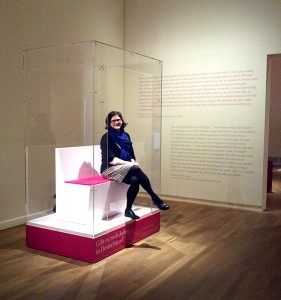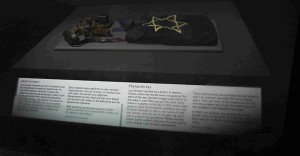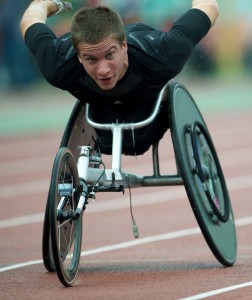My Two Hours as a Living Exhibition Object in the Show “The Whole Truth“
This was a truly extraordinary experience. The best moments were when the visitors started talking not just to me but to each other, and we wound up talking about Wagner and the weather rather than ‘just’ about growing up Jewish – or, more specifically, in my case as the daughter of a Jewish-American mother and a German, (formerly) Protestant father – in Germany and how odd it was to be sitting in a glass showcase in an exhibition.

Signe Rossbach in the exhibition “The Whole Truth”, April 8, 2013
© Jewish Museum Berlin, photo: Michal Friedlander
I was reminded of the moment in 1998 when I returned to Germany from the U.S. (although I did not want to see it that way at the time). The German publisher I was working for in New York had just been appointed State Minister of Culture by Gerhard Schröder, and I continued working for him in the Federal Chancellery, first in Bonn, then in Berlin. Back in New York, an editor at Henry Holt said to me: “Well, well, isn’t that a great job for a good little Jewish girl, working in the German government?” I thought about it, and said: “Exactly.”
So, I guess this was what brought me to sit in a glass showcase in a show at the Jewish Museum Berlin, where I have been working for twelve years now, on a seemingly quiet Monday afternoon. In my two hours of being a living exhibition object, I … → continue reading
“Axis of the Holocaust” is the designation of one of three corridors in the museum’s basement. Display cabinets are inlayed in the wall. They contain photographs, pieces of writing, and objects that convey the stories of people who survived or were murdered in the Holocaust.
They contain photographs, pieces of writing, and objects that convey the stories of people who survived or were murdered in the Holocaust.
In one window lie phylacteries and a pouch with an embroidered Star of David. These objects belonged to Leo Scheuer. He gave them to the museum shortly before his death. → continue reading
Just a few weeks ago in Stoke Mandeville, England, a large bronze statue was unveiled in honor of a Jewish physician from Breslau, who – despite his moving story, his pioneering efforts, and the international significance of his work in Germany – is virtually unknown here:

Marc Schuh, wheelchair racer (medium distance), member of the German team at the London Paralympics, 2012 © Behinderten-Sportverband Berlin e.V.
Ludwig Guttmann, the father of the Paralympic Games that were opened in London on 29 August. More than two and a half million spectators will cheer on the over 4,000 athletes there. Guttmann is well-known in Britain, where he was awarded the Order of the British Empire and where the BBC made a film about him entitled “The Best of Men.”
Ludwig Guttmann was born to an orthodox Jewish family in Tost, Upper Silesia in 1899. He grew up in Chorzów, where he worked at the hospital for the first time with paraplegics. Following his medical training in Breslau and Freiburg, he specialized in the young field of neurosurgery from 1924 and was soon considered one of its leading doctors. After Hitler’s rise to power in 1933, Guttmann was no longer permitted to practice in a public hospital. Despite several offers from America, he stayed in Germany and took up a specialist post at the Jewish Hospital in Breslau where he later became director. When he learned of the violent excesses during the November Pogrom in 1938, he instructed his staff to admit all refugees to the hospital without examination. In spite of a Gestapo investigation at the hospital, he was able to save 60 Jewish citizens from arrest and deportation to a concentration camp. → continue reading


